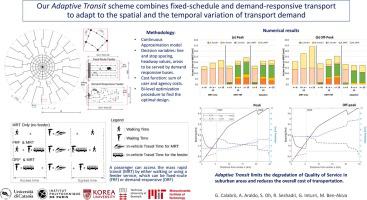Transportation Research Part A: Policy and Practice ( IF 6.4 ) Pub Date : 2023-03-13 , DOI: 10.1016/j.tra.2023.103643 Giovanni Calabrò , Andrea Araldo , Simon Oh , Ravi Seshadri , Giuseppe Inturri , Moshe Ben-Akiva

|
In most cities, transit consists solely of fixed-route transportation, whence the inherent limited Quality of Service for travellers in suburban areas and during off-peak periods. On the other hand, completely replacing fixed-route (FR) with demand-responsive (DR) transit would imply a huge operational cost. It is still unclear how to integrate DR transportation into current transit systems to take full advantage of it. We propose a Continuous Approximation model of a transit system that gets the best from fixed-route and DR transportation. Our model allows deciding whether to deploy a FR or a DR feeder, in each sub-region of an urban conurbation and each time of day, and to redesign the line frequencies and the stop spacing of the main trunk service. Since such a transit design can adapt to the spatial and temporal variation of the demand, we call it Adaptive Transit. Numerical results show that, with respect to conventional transit, Adaptive Transit significantly improves user-related cost, by drastically reducing access time to the main trunk service. Such benefits are particularly remarkable in the suburbs. Moreover, the generalized cost, including agency and user cost, is also reduced. These findings are also confirmed in scenarios with automated vehicles. Our model can assist in planning future-generation transit systems, able to improve urban mobility by appropriately combining fixed and DR transportation.
中文翻译:

自适应交通设计:通过连续逼近优化固定和需求响应多式联运
在大多数城市,公共交通完全由固定路线交通组成,因此在郊区和非高峰时段为旅客提供的服务质量固有有限。另一方面,用需求响应 (DR) 交通完全取代固定路线 (FR) 将意味着巨大的运营成本。目前尚不清楚如何将 DR 运输整合到当前的交通系统中以充分利用它。我们提出了一个交通系统的连续逼近模型,该模型从固定路线和 DR 交通中获得最佳效果。我们的模型允许决定是在城市群的每个子区域和一天中的每个时间部署 FR 还是 DR 馈线,并重新设计主干线服务的线路频率和站点间距。由于这样的交通设计可以适应需求的时空变化,自适应交通。数值结果表明,相对于传统公交,自适应公交通过大幅减少对主干线服务的访问时间,显着降低了与用户相关的成本。这种好处在郊区尤为显着。此外,包括代理成本和用户成本在内的广义成本也降低了。这些发现也在自动驾驶车辆的场景中得到证实。我们的模型可以协助规划下一代交通系统,能够通过适当结合固定交通和 DR 交通来改善城市交通。


























 京公网安备 11010802027423号
京公网安备 11010802027423号